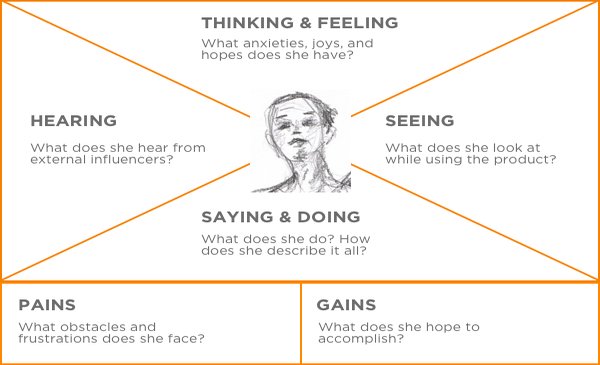Most marketers and business leaders generally agree that brand can be a key asset, helping facilitate demand, encourage growth, ensure consistency of users and create advantage. While the world around us has changed dramatically, and impacted how we consume, buy and sell, approaches to marketing and brand building have largely stagnated. Most feature models, structures and thinking from decades ago that tend to focus on the importance of rational, hierarchal-based thinking and create constructs designed to mimic a deliberate decision-making process.
We now know more about how the human brain processes information and triggers our behaviors than ever before, for example, we know that the majority of the decisions we make are based on emotion and instinct, not rational thought and measured consideration. It’s been revealed that our decisions are the result of less deliberate, linear, and controlled processes than many of us realize.
What this suggests is that, in order to impact and affect decision making, you have to appeal and connect to people’s emotions. Playing to rational considerations is not a compelling motivator. Human beings react intuitively to everything they perceive and base their responses on those reactions rather quickly. Within the first second of seeing something, hearing something or meeting another person, impressions are made and actions are born. Intuitions come first. This suggests that the prevailing traditional models, constructs and methodologies that we have used for decades to drive our marketing and communications efforts outweigh the importance of rational thinking and are not as effective as they could be.
This led us on a seven-year journey to uncover a new and better way forward. The adventure is detailed and document in our book Brand Intimacy: A New Paradigm in Marketing, that is equal parts theory, research and practice. We reviewed relevant marketing models and methodologies, books, articles and research studies on how changes in brands and technology are impacting the modern consumer. We assessed multiple theories, models and doctrines from psychologists, scientists, and economists, all who have published on topics related to the science of decision making. We then moved into our extensive study on the psychology of intimacy, looking to understand historic and academic approaches, as well as some initial thinking into the realms of intimacy and marketing.
Our custom qualitative research provided 20,000 unique stories from more than 350 people, based on 1,000 hours of insights. In addition to our insight communities, we completed an online content analysis through an algorithm created to search queries for 110 keywords, identified from our insight communities, across three contexts: personal, social and environmental, looking on blogs, social networks and communities. This started to more concretely shape our thinking and we found that Brand Intimacy parallels human intimacy and people form relationships with brands in a similar way they establish relationships with other people.
Our thinking was furthered with quantitative research designed to help us understand the extent to which consumers have relationships with brands and the strength of those relationships across a variety of industries. We have modeled data from 12,000 interviews and approximately 100,000 brand evaluations to quantify the mechanisms that drive intimacy. Through factor analysis, structural equation modeling and other analytic techniques, this research enabled us to understand which levers most affect building intimacy between brands and consumers.
Brand Intimacy Model
This research led us to a new way of thinking and a new approach designed for today. Brand Intimacy is a new paradigm that measures and leverages the emotional bonds between a person and a brand. We created the Brand Intimacy Model comprised of key components including:
Being a user: To be intimate with a brand, you need to have repeatedly tried it or be engaged with it. Think of this in terms of human relationships; you cannot be intimate with someone you don’t know.
Strong emotional connection: Emotional connection is at the heart of Brand Intimacy and aligns with all we’ve learned about decision making from neuroscience and behavioral science. To start an intimate brand relationship, a consumer must exhibit a strong emotional connection with a brand. Not everyone who has an emotional connection with a brand is necessarily intimate with it; however, everyone who is intimate with a brand has a strong emotional connection.
Archetypes: Six patterns or markers are consistently present, in part or in whole, among intimate relationships. They identify the nature and character of these relationships. A factor analysis from our quantitative research validated and refined the archetypes, which were discovered through our earlier qualitative work. We observed how people explained and defined their close brand relationships, and over and over the same types of words and experiences were used to explain the bond a person felt with a brand. The more we reviewed these, the more we realized these markers were among the most effective tools to leverage in building brand intimacy. The six archetypes are: fulfillment, identity, enhancement, ritual, nostalgia and indulgence.
Stages: These measure the depth and degree of intensity of intimate relationships. Each of our three stages (sharing, bonding and fusing) comprises a number of emotional and rational milestones that are achieved when brand relationships become more intimate. People might vacillate between two stages before moving forward; some stages, due to a variety of potential factors, might move faster or slower than others. These stages of brand intimacy are grounded in psychology and have been further corroborated by our quantitative research with consumers.
Brand Intimacy Quotient: This is a score out of 100 assigned to any brand that is part of our Brand Intimacy research. The score is a shorthand way to compare brands within and across categories, as well as to identify a brand’s performance in terms of generating brand intimacy. (For example, in our most recent study, Apple was the highest ranked intimate brand, with a score of 77.) The score is based on prevalence (the percent of intimate users a brand has), as well as degree of intensity of the stages.
Intimate Brands
Any brand of any size can apply the principles of brand intimacy to succeed. Essentially this involves building deeper and stronger bonds with stakeholders by leveraging emotion and reciprocity. This requires examining the bonds a brand currently has with its priority audiences and assessing their strength. It also requires a brand to be grounded in a strategy that enables it to forge powerful emotional connections and has design and communications that resonate with the right audiences and invite engagement. Managing a brand effectively and optimizing the marketing mix is key to ensure its channels and campaigns are aligned and relevant.
We conduct an annual study that ranks almost 400 brands across 15 industries which provides interesting perspectives on intimate brands across gender, age, income and industries. With Harley-Davidson ranked fourth in our study, BMW ranked ninth and Toyota, 10th, Automotive is the most intimate category in our study. Travel is the least intimate industry. Financial Services performs above average, while Luxury is below average. These may be surprising results as who thinks of financial services brands as particularly intimate, or luxury brands as unsuccessful in building ultimate relationships? This further demonstrates brands that apply the principles of Brand Intimacy can succeed. In fact, the top 10 most intimate brands outperform established financial indices – the S&P and Fortune 500 – for both revenue and profit growth over 10 years. In addition, these brands command a price premium, enjoying more financial resilience than brands in the same industries that are not intimate.
Netflix ranks fifth overall in our study. While it is well known, it is not the brand that is the biggest or most established in brand in its category (Media & Entertainment). Let’s look at a little closer to see how and why Netflix is a strong intimate brand.
Clearly, Netflix has been the beneficiary of streaming and binge-watching trends, with a 12 percent month-over-month increase in binge-watching among its U.S. users in 2016, and a jump from approximately 75 million subscribers in 2015 to nearly 94 million in 2016. In January 2016, Netflix launched in 130 countries around the world and by the end of 2016, it had released an estimated 128 original series/films (more than any other single network or cable channel in the U.S.).
There’s no doubt that the brand’s expanded audience and explosion of original content as well as its seamless technology platform have improved Netflix’s ability to form more intimate bonds with consumers. The brand has seen a dramatic improvement in its scores for the industry’s two most associated archetypes. From our previous study, Netflix has moved from #10 in the category for indulgence to #2, and for ritual, has gone from #5 to #1.
Apart from a few favorable trends, Netflix’s business success and rise in Brand Intimacy stem from its complete commitment to understanding and satisfying its users. Using a global algorithm that looks past demographics like geography, gender and age, Netflix organizes its users by what they like, and makes recommendations based on viewers with similar tastes from all over the world. This creates a sense of being anticipatory and understanding its customers, gaining traction in building relationships. Netflix has also rolled out new features that give its users more freedom, like an offline viewing option and in-app subscriptions for their iOS app (which quickly made it the top-grossing app in the U.S. App Store). Netflix hasn’t been blind to the consumer escapism and nostalgia trends, either. Of its top five most popular shows of 2016, three were sci-fi/fantasy (#2 “Stranger Things,” #4 “Luke Cage” and #5 “Daredevil”), and #3 was the nostalgia-heavy “Full House” revival, “Fuller House.” With more content, more options, and a better understanding of its users, Netflix has been able to establish itself as a staple in people’s lives, something they rely on to make life easier and more enjoyable. We expect Netflix and the Media & Entertainment category to continue to grow in intimacy, as their content becomes more accessible, more targeted and more immersive, allowing brands to form stronger bonds with consumers.
We know today’s marketplace is constantly evolving. We also know the biggest indicator of purchase is how we feel about a brand. Ultimately, companies need their brands to drive tangible results. Whether a company is a small start-up or a massive multibillion dollar conglomerate, Brand Intimacy can create incremental or transformational improvements. We encourage all marketers to build deeper bonds, link to emotions and amplify their relevance through increased intimacy. As with any relationship, the more you put in, the more you get out.
Contributed to Branding Strategy Insider by: Mario Natarelli and Rina Plapler. Excerpted from their new book Brand Intimacy – A New Paradigm in Marketing.
The Blake Project Can Help: Accelerate Brand Growth Through Powerful Emotional Connections
Branding Strategy Insider is a service of The Blake Project: A strategic brand consultancy specializing in Brand Research, Brand Strategy, Brand Licensing and Brand Education




